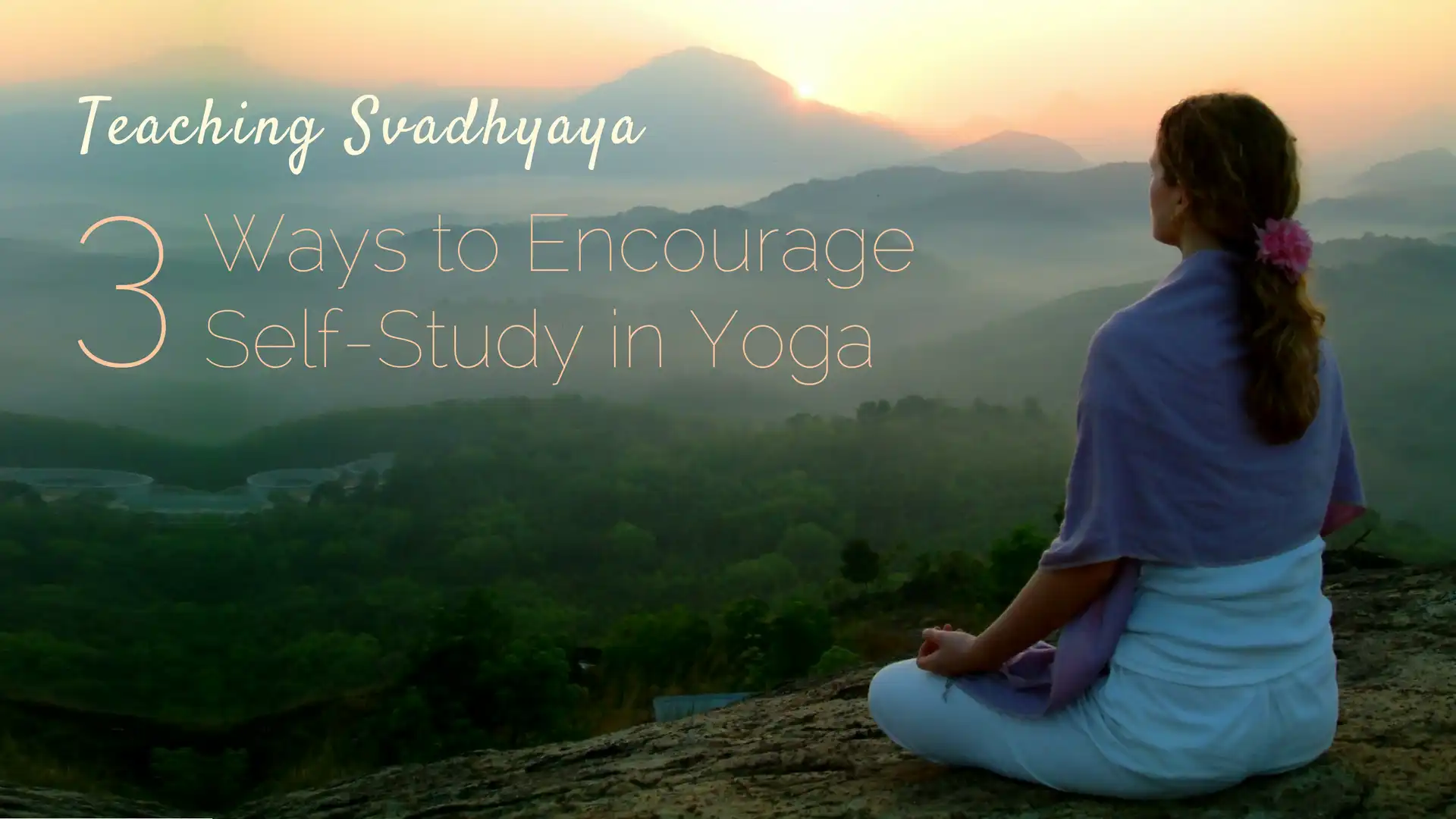Teaching Svadhyaya: 3 Ways to Encourage Self-Study in Yoga

As yoga teachers, our job is to teach yoga. Which means more than just teaching our students how to do yoga poses and how to breathe properly. It’s also our duty to impart some of the deeper wisdom and more meaningful lessons of the larger yoga tradition—to remind our students of the bigger picture, why we really practice, and what yoga is truly all about.
The Deeper Wisdom of Yoga – A Wholistic Approach to Wellbeing
After all, yoga isn’t concerned with building strength, gaining flexibility or perfecting postures. Yoga is interested in the self: self-awareness, discovery, acceptance and, of course, self-realization.
A complete approach to total wellbeing, yoga is considered to be both an ancient belief system (with accompanying practices), and a method for personal and spiritual development. Hatha yoga, or the practice of yoga poses, is just one branch of the larger tradition of yoga. It just happens to be the branch that has become exceedingly popular with our physically oriented society. However, the practice was never intended for the sole purpose of being skilled at performing the asanas. Rather, the practice itself teaches you and you learn about yourself along the way.
The Yogic Practice of Self-Study, Svadhyaya
Enter the practice of svadhyaya, or self-study. One of the five niyamas, or personal observances, on Patanjali’s eight-limbed yogic path, svadhyaya implies the study of scriptures as well as the study of oneself. It’s the process of turning your attention inward, observing and reflecting upon your thoughts and emotions, reactions and habits, beliefs and desires, etc., for the purpose of having a deeper experience and understanding of oneself. While svadhyaya is typically thought of as something done on your own, seated in quiet contemplation, any time spent on your mat is an opportunity to get to know yourself more deeply.
It’s fair to say that not many of our yoga students regularly engage in contemplative self-study. So it’s essential that we give them the opportunity to participate in svadhyaya while we have their attention on the mat, so that we incorporate more yoga into our asana practice.
Not only will your students begin to understand themselves better, but they’ll better understand their bodies as well! Encouraging svadhyaya on the mat significantly increases body awareness and boosts confidence as you invite your students to pay attention to their own direct experience and empower them to make skillful choices.
3 Ways to Cultivate Svadhyaya in Yoga Classes
1. Spend More Time Directing Your Yoga Students’ Attention Inward
Between the music, décor, demos, and even the teacher’s cues, it’s fair to say that asana classes have become increasingly externally driven events. Students can easily come and follow and flow along without ever having to pay any real attention to their own direct experience, never checking in with what’s taking place on the inside.
As yoga teachers we have to give our students the time, tools and space to become aware of their inner worlds—the emotions, feelings, thoughts and sensations taking place within—throughout their yoga practice. In order to do so, we have to offer moments of pause (and silence!) throughout class, whether that’s in Tadasana (Mountain Pose), Balasana (Child’s Pose), or between sides. In these moments we can direct our students’ attention inward, inviting them to notice what’s arising.
For example, after a few rounds of Surya Namaskar (Sun Salutations), I always incorporate a pause, asking my students to notice the fluctuations of energy or sensation pulsating through their bodies. During longer holds I often tell my students to watch how their minds react, or where their minds go when I stop talking for a few moments when they’re in a pose like Adho Mukha Svanasana (Downward Facing Dog Pose). Essentially I want my students to be able to pay attention to their inner experiences as much as their outer ones, and in the process, become a little more familiar with their internal worlds.
2. Ask Your Students Questions to Reflect Back Upon Throughout Yoga Class
Something I often ask my students at the very beginning of class is, “Why do you come?” Why do you choose to come to yoga when there are a thousand other things you could be doing? Why did you start practicing yoga, and are those the same reasons you continue to come?
The answers are unimportant to me. There are no wrong or better, more “yogic” answers, as I like to tell my students. The questions are intended to get them thinking a little bit more about themselves and their personal reasons for coming to yoga, inviting them to allow that to be the guiding factor of their practice. I then remind my students throughout class that it doesn’t particularly matter to me if they do this, that or the other, and that I don’t know their personal reasons for practicing yoga. However, they need to know why they are doing what they do and make choices accordingly.
My yoga students then have to stay engaged in self-study throughout class with the open invitation to personalize their practice, rather than simply following along blindly.
3. Give Your Yoga Students a Lot of Options Throughout the Class
In order for students to be able to make skillful personal choices, they have to know that (a) they have options and (b) what those options are. For the most part, yoga students have become so used to being told what to do and how to do it on the mat that a large majority of them check their personal autonomy at the door. They need to be reminded that they have choices. By the same token, offering various options for students to consider for themselves and choose from automatically engages them in the practice of svadhyaya.
While I don’t teach flow yoga anymore, when I did, I always offered my students a variety of choices to consider in place of Chaturanga Dandasana (Four-Limbed Staff Pose) and Urdva Mukha Svanasana (Upward Facing Dog Pose). The choices included moving straight to Adho Mukha Svanasana (Downward Facing Dog Pose) or Child’s Pose, holding Phalakasana (Plank Pose), or practicing Chakravasana (Cat-Cow Pose), depending on their personal needs, whether those needs included was taking a rest, building stability or going for spinal extension. They had to decide every time, creating tiny moments of svadhyaya throughout practice.
Now I mostly teach students how to determine the wise or productive position for their own bodies in any given yoga pose, offering them a handful of options until they determine the one that suits them best. This includes not doing the pose altogether if it’s unwise or counterproductive for their body. For example, I invite my students to try different hand positions in Downward Facing Dog Pose (taking them wider, spinning the fingers out, etc.) until they find the one that creates more stability through the arms without creating any counterproductive sensations in the neck.
More practice tips on Svadhyaya from YogaUOnline – Judith Hanson Lasater on Svadhyaya: Remembering the Self.
 Meagan McCrary is an experienced yoga teacher (E-RYT 500) and writer with a passion for helping people find more comfort, clarity, compassion and joy on the mat and in their lives. She is the author of Pick Your Yoga Practice: Exploring and Understanding Different Styles of Yoga a comprehensive encyclopedia of prominent yoga styles, including each system’s teaching methodology, elements of practice, philosophical and spiritual underpinnings, class structure, physical exertion and personal attention. Currently living in Los Angeles, Meagan teaches at the various Equinox Sports Clubs, works privately with clients and leads retreats internationally. You can find her blog, teaching schedule and latest offerings at www.MeaganMcCrary.com.
Meagan McCrary is an experienced yoga teacher (E-RYT 500) and writer with a passion for helping people find more comfort, clarity, compassion and joy on the mat and in their lives. She is the author of Pick Your Yoga Practice: Exploring and Understanding Different Styles of Yoga a comprehensive encyclopedia of prominent yoga styles, including each system’s teaching methodology, elements of practice, philosophical and spiritual underpinnings, class structure, physical exertion and personal attention. Currently living in Los Angeles, Meagan teaches at the various Equinox Sports Clubs, works privately with clients and leads retreats internationally. You can find her blog, teaching schedule and latest offerings at www.MeaganMcCrary.com.



